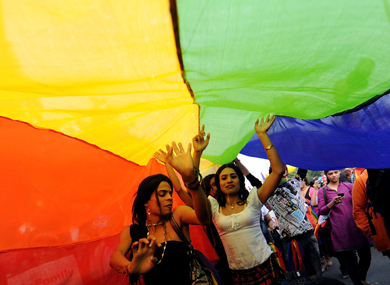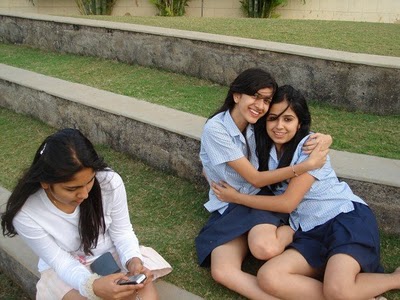In a lot of ways, the only constant in India is change. The subcontinent that’s home to one of the oldest civilizations in the world is also becoming a global technology hub; it’s a nation that encompasses a lot of contradictions, rocketing forward into the future while still considered a developing nation in a lot of senses by the rest of the world.
For gay people, India’s a complicated place to live. Homosexuality was decriminalized in Delhi’s high court in 2009, but it’s still not necessarily feasible to live openly as a gay person, especially in the more conservative southern half of the subcontinent. Like everything else in India, though, that’s always changing, and progress is happening in fits and starts but can’t be ignored.

This week, the Times of India has taken note that (at least in Kolkata) there’s been a “sudden increase in same sex relationships among schoolgirls.” Specifically, the article says that female students are increasingly seeking out counseling services around their relationships, implying that this is more of an identity claimed with agency than a problem to be fixed, as was more common in the past — the “occasional case where parents hesitatingly came with the “queer” girl.” That doesn’t mean the Times is ready to use the world “lesbian,” though.
Mind doctors do not wish to typify such bonding among schoolgirls within the lesbian frame just yet. They say from experience that girls often get into deep bonding with the same sex because at that young stage, it is difficult to get close to members of the opposite sex, considering the traditional social conditioning that binds us. The excitement of their sexual awakening, coupled with biological changes happening inside their bodies need to be channelized, say psychiatrists. In many cases, this happens in girlie bonding with sparks of physical closeness and should not be confused with sex just yet, feel counsellors.
This view may be at least a little less outrageous than it sounds to Americans. Schoolchildren in India do live a very gender-segregated day-to-day life; the observation that “it is difficult to get close to the opposite sex” is certainly true, even if it doesn’t explain why that would suddenly result in an out-of-nowhere uptick in lesbionic attraction. It’s also true that platonic same-sex affection is much more common in India than in the West — a pair of same-sex friends holding hands wouldn’t raise an eyebrow. For counselors who likely have little training in how to respond to or care for kids (the article claims that counselors are dealing with girls as old as 16-18 but as young as 9-10), the conclusion that young girls might be transferring their confusion and anxiety about sex onto their friends is probably an easy one to draw. Given the lack of discussion on sex and relationships in school or the home, it’s not an unreasonable to assume that kids are at least somewhat confused.

At least one counselor, even if she doesn’t necessarily validate these girls’ identities, sees the recent trend as a step forward — someone at least making part of the conversation more public.
” After getting into a relationship like this, fear often sets in and young girls start asking questions about whether such bonding means they are lesbians. It is this fear that brings them to counsellors. The fact that same sex relationships are taboo in our society plays on their minds and depresses them,” [counsellor Saloni Priya] said.
But based on what’s happened with queer issues in India in the last few years, it might make more sense to guess that these students are responding to having more information than before, not a lack of it. Media representation of Indian lesbians at least exists now, which isn’t saying much, but is a huge improvement over the previous radio silence. The recent plight of a lesbian couple from Gurgaon captured the attention of the media worldwide, shedding light on the fact that same-sex couples do live in India, and also that they face being ostracized from their home communities and sometimes terrible danger. Now, for the first time, an Indian high court will rule on not just the criminal status of homosexuality, but the legality of same-sex marriage. The Punjab and Haryana High Court has been asked to rule on the case of Baljit and Rajwinder Kaur, who consider themselves to have been married for the past year and want their union recognized under the Hindu Marriage Act of 1955. Justice Rajan Gupta has “directed the government to consider the women’s request, observing that the “state is duty bound to protect life and liberty of citizens under Article 21.”

There’s no indication the Kaur couple will win their case; it’s entirely possible (and given the strong traditions around family and marriage, maybe probable) that the counselors in the Times’ article are right, and many of the girls who are now coming for support in their same-sex relationships will end up marrying men. But it seems like the schoolgirls in Kolkata are maybe less of a shocking surprise development and more part of a narrative that’s been unfolding for years and which will only bring more freedom and social mobility for the queer community of India.








Comments
For a country that is so sheltered from the Western world’s view of sexuality, whether gay or straight, India’s progress on the queer front is fairly remarkable.
Most people in India adhere to a culture that has religion incorporated into day-to-day life and separation of church and state means very little in such a religion-heavy society. It’s possible that BECAUSE Hindu texts say absolutely nothing about gay people that most Indians just don’t know how to deal with these issues, and instead decide to go into denial.
As an Indian gaymo, this really made me smile. Thanks for an informative article, Rachel!
As a lesbian, and a half Indian one at that, I concur!
The first pic makes me smile =)
Good article. I can kind of agree with the hesitation in immediately labelling the girls as “lesbian”: this reminds me of a lot of homogendered ‘sub’cultures, (like all-girl boarding schools), in a lot of societies where girls pair up because of emotional bonds rather than sexual attraction. Who knows, maybe this sort of behaviour will normalize being in homosexual relationships as adults.
It brings to mind the romantic friendships between women at the turn of the 20th century (and for centuries before that, too).
Thanks for this article! It was really well-done. While I’m not Indian, I do have a lot of Indian friends (and they are all wonderfully accepting and supportive! <3), so this was definitely especially interesting for me to read about.
I totally agree with you! But the fact that they are seeking for counselling means they’re not as afraid as they used to be! So, yay!!
Great article!
I was born and raised in India until I was 15. I attended an all girls catholic school. We were a group of 13 friends. We pecked each other on the lips first thing in the morning as a greeting and never once thought about our sexuality. We were all very close as friends but we also had our favorites within the group and those favorites acted more like girlfriends, unbeknownst to any of us including the pairs.
There was no word for gay or lesbian in our language. I still don’t know if there is such a word. Even if there was a word, no one at our homes or school used it. To any of us, the word lesbian or what it meant did not exist. So if there are no words, there are no concepts and when there are no concepts, you can’t define yourself or the situation……..we really didn’t know we had queer tendencies or interest. We just knew we were close and loved each other.
Culturally women are not told about a sexual choice. I am not sure how things are now but when I was a young girl there was no discussion of sexuality period. Things we couldn’t think about asking our parents we discussed amongst ourselves. This freedom to be able to speak our minds without fear and censorship about any topic was amazing and what also contributed to our closeness.
I would hate to see these schoolgirl friendships labeled and controlled in some way. I am glad they are not too eager to label things. Once it gets labeled, would parents and school teachers then watch the relationship for fear of any sexual expression? Downside of not labeling is, things stay in the closet.
you won’t believe but right now a television show is going on with gay men theme called-MARYADA…LEKIN KAB TAK?
For something as conservative and orthodox as Indian Television, this is definitely a huge step. I was so glad to see the positive way in which the story of these gay guys is being handled. One of them is forced to marry a girl and that ruins even the girl’s life however the wife decides to support her husband’s ‘love’ and moves out of the way herself!
Last night one of the guy’s mom tries to ‘cure’ him and the guy says- “WHAT DO YOU WANNA CURE MOM? I AM NORMAL, PERHAPS MORE NORMAL THEN YOU HATERS!”
Now for Indian television this is a giant step. However the show airs very late at night but i wish it should be made at prime time so that more people should see this and realize that gay people are normal and not psycho killers or abnormals as is propagated by our religious leaders.
However i wish to see some lesbian girls on Indian movies & television and not those lesbians who are just ‘waiting for the right man’ as shown in DELHI BELLY, but real lesbians who don’t kill anybody, are normal and searching for the right lady!
Hope that day shall also come soon. But thnx for this article anyways. Gives us poor lesbos some hope. I haven’t come out to my parents, can’t even imagine doing it or my brother would def suggest to give me electric shock to ‘cure’ me! Just pray for me folks that at least i should get one little kiss from some real girl before i chock!
Justso, I REALLY hope that you find your girl soon! :)
I am Indian, now living in Vancouver, Canada and this is a link to my coming out story: http://www.flygirlproductions.com/read/1-of-the-7-tales-of-pride-featured-in-lov-magazine/. Maybe this can be useful in some way.
Great to hear of the TV show and hope a positive lesbian show would be next.
Good luck with everything.
so nice to see that also in Idia, 2 women couyld be in love together
You r not aware of india…its a vast country with a wast culture n mindsets……U got a lot of choices….but u will not come up….u can do it with a man or or women irrespective of ur sex…nobody bothers.. Until others are aware of that.I think u got the difference……